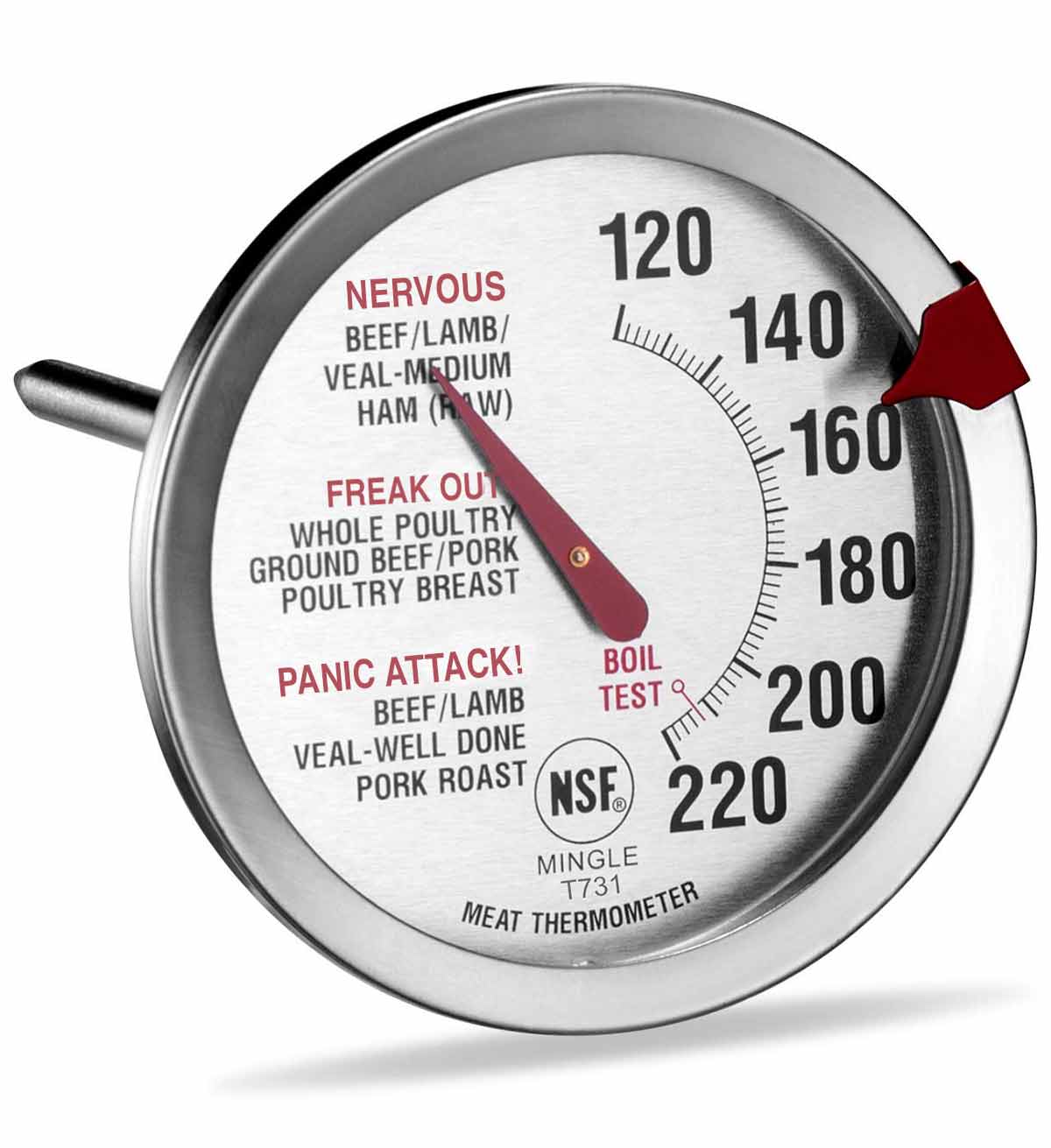
For a long time, every year when it came to the interminable turkey-eating season—November to New Year’s Day—I stood there holding a meat thermometer, hands trembling, face twitching, wondering if this bird would be the one I actually cooked correctly. You see, it seemed no matter what I did, I missed the thickest part of the turkey thigh so spectacularly that, for a while, I left the protein-cooking part of the day in The One’s hands and I took up the immensely less intimidating baking portion of the entertaining program.
But not before one memorable Thanksgiving when I had to call our friend Matty, a former butcher, into the kitchen to salvage the bird, not to mention my flagging self-esteem. (To his great credit, Matty, a man who’ll use anyone’s misfortunes as grist for a few minutes of hilarious stand-up cocktail chatter, never breathed a word of it to anyone. At least, never in my presence.)
What happened was the bird was done an hour before it was supposed to be. Or I thought it was. The guests had already arrived so I made some excuse about setting the timer incorrectly and corralled everyone into the dining room before they even had a chance to enjoy a glass of wine and my homemade bow tie cheese straws. Then, when I carved the breast (thankfully in the kitchen), it was like watching a scene from Saw V–bloody hell.
Apparently, in my haste, I had pushed the digital thermometer into the thickest part of the thigh and right on through the other side and into the bird’s unstuffed cavity. There, the probe became superheated super-fast, not giving the turkey enough time to roast properly. So I shooed everyone back into the living room (except Matty), and we reassembled the bird, stuck it back in a slow oven, then all of us had to make that one bowl of bow tie cheese straws and some roasted Marcona almonds last an hour.
My problem was: How to tell where the thickest part of the thigh was so I could jab a thermometer into it? It seemed like a no-brainer, but without an arthroscopic camera attached at the end of my thermometer’s probe, I was lost. Then I discovered an absolutely surefire way of hitting that sweet spot every time, and my birds have been perfectly cooked ever since.
How to find the thickest part of the turkey thigh
Go ahead and roast your turkey using whichever method suits you. To take its temperature, remove the beast from the oven after 30 minutes and stick the thermometer into the thigh. I use an ovenproof digital thermometer with an alarm so I can monitor the temperature during cooking. Now, jab around in there, you’ll see the temperature rise and fall. Find the coldest spot. That’s where the least amount of heat has penetrated and therefore it’s the thickest section.
Leave the thermometer where it is, slide the bird back in the oven, and wait until the desired temperature is reached. I go with 165°F (72°C). I feel comfortable with that. For the longest time the USDA said 180 to 185°F (82 to 85°C) was the proper thigh temperature, and the result was a bird that was chokingly dry. But in 2006, the department mercifully revised its temperature rules, which means we all have a chance for a better, juicier turkey.
Of course, they still demand a high 160°F (71°C) for medium pork, but I never go above 145°F (63°C), and, hey, I’m still here. But that’s another story best left for a different holiday. Originally published November 9, 2008.












Hi David
Can you tell me what brand of ovenproof digital themometer with an alarm did you use to test the turkey.
Jackie, the brand I have is CHEFS, but it’s no longer being made. It’s similar to this thermometer. Now, I’m not recommending this one, as I haven’t tried it, but the reviews look good.
The thermometer shown, like its more expensive Thermapen version, is NOT oven-safe.
Be careful with it.
gloria, you’re correct. But the method I discuss is simply taking the temperature of the turkey then sliding fit back in. It’s not meant to stay in the oven while the turkey roasts.
U ARE MY HERO…. I think…. let u know after I cook my $ heritage birdy.
pa lo, now you’ve got me nervous! Those birds are quite expensive. Please do let me know, and Happy Thanksgiving.
Ah, turkey roasting! I’m afraid I follow one of those arcane rituals involving brown paper grocery bags (learned from my grandmother) and searing temps, until I lower it to something more normal. Do not use a clock or timer, just my sniffer to tell me it’s just about time, and the old poke a knife between the leg and the body to see if the juice runs pink or not.
It’s always been done when everything else was ready. Like I said, arcane. Don’t know how or why, but it’s always worked for me.
Leave the protein portion to them what enjoys the gig. You do the orgasmically delicious desserts that very few can master.
ruthie, that means you are a born roaster. And they’re far and few between. My mom is one and can smell when a roast is done–even from the basement!
The best thing about Thanksgiving for me is indeed the dessert. Well, that and the stuffing. And the mashed potatoes. And, well, the gravy. In fact, my least favorite part of Thanksgiving is the turkey. Hmmmm.
That’s because you harbor hidden resentment, secretly blaming it for your roasting…um…comeuppances. LOL! I know what you mean about loving the whole deal, though. I have to do turkey at least two or three times a year. It’s the only way to avoid that turkey coma and the accompanying discomfort at Thanksgiving. When I know I don’t have to wait another year for my fix, I can control myself.
So few people, me included, make turkey only once a year. I was speaking to several Brits and Canadians when The One and I were on a cruise recently, and they make whole turkeys all the time. We should take a page from their cookbook…so to speak.
OMG David!!!
That is so me!!
Piles of everything else on my plate and a small sliver of ?!!!?
I hear you, Sarah!